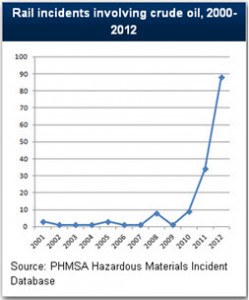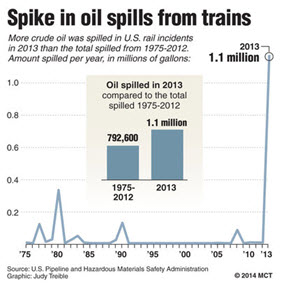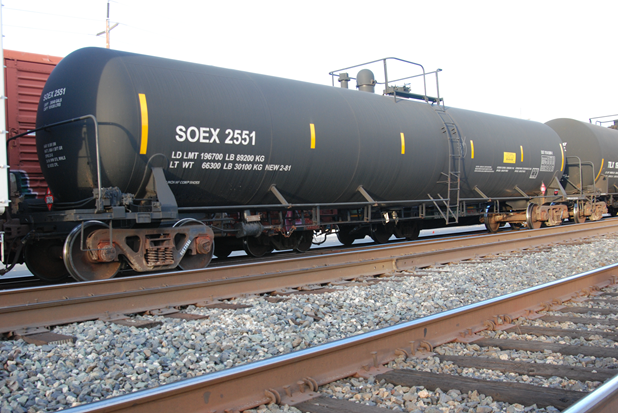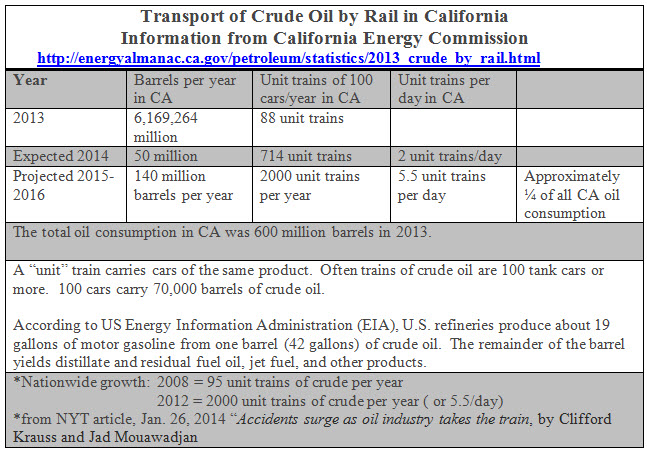By Lynne Nittler, Milton Kalish, and Matt Biers-Ariel
Background: North Dakota Bakken crude oil production is booming, and oil companies are looking for a fast, convenient way to transport their sweet light crude oil to refineries across the U.S., including to the five refineries in the Bay Area.
A vast network of railroads crisscross the nation, making “unit trains” of 100 oil tank cars or more, an efficient and flexible method of transportation. In the last few years, crude-by-rail shipments have increased tenfold. According to a New York Times article, about two-thirds of the production in North Dakota’s Bakken shale oil field rides on rails, as there is no pipeline infrastructure. As of 2013, more than 10 percent of the nation’s total oil production is shipped by rail. (from Accidents surge as oil industry takes the train, by Clifford Krauss and Jad Mouawadjan, Jan 26, 2014).
The number of oil trains nationwide is expected to increase significantly more in 2014 and beyond.
Crude-by-rail is skyrocketing in California. According to the California Energy Commission, in 2013 railroads hauled more than over 6 million barrels of crude oil in California. In 2014 that number may jump to 50 million barrels or more, and by 2016 rail transport is expected to reach nearly a quarter of California’s total oil consumption, or approximately140,000 barrels per day.
Benicia Valero Proposal: Valero petitioned Benicia to allow the oil refinery to enlarge its train terminal in order to increase its production by 70,000 barrels of crude every day. That’s enough to fill 100 sixty-foot-long tank cars with highly flammable crude oil. The Benicia Planning Commission has the power to approve the new rail terminal….or turn it down. Responding to pressure from citizens and a study prepared by the National Resources Defense Council, Benicia is currently preparing a draft Environmental Impact Review (EIR) for the project that will be available for written public comment sometime after the end of January.
The Danger: There are major problems posed to the communities and the sensitive areas the trains pass through. The unsafe tank cars with their volatile cargo pose an immediate and serious safety risk.
Accidents as warnings: A rash of recent fiery accidents prove the point. In the last year there have been 10 major rail accidents involving oil trains in the U.S. and Canada. Last July, 47 people perished in a massive fireball when a train containing Bakken crude derailed and exploded in the Canadian town of Lac-Megantic, Quebec. Four more oil trains have derailed in Canada since then.

In November, a train carrying the same Bakken crude derailed in Alabama, possibly caused by trestle tracks that collapsed under the weight of the heavy tank cars. Twelve of the cars exploded, fortunately not in a populated area. In the last week of December, another 18 tank cars carrying Bakken crude derailed and exploded just outside of Casselton, North Dakota, forcing the town to evacuate to avoid the plumes of toxic smoke from the ensuing fires that burned for more than a day. Another oil train derailed and exploded in New Brunswick days later. There is no attempt to put out these massive fires; first responders simply keep people back and watch until the fires die down.
The main problems: If the Benicia Valero Project is approved, trains carrying highly flammable Bakken crude oil in the outdated DOT-111A tank cars (intended for non-flammable liquids such as fertilizer) will pass through the center of Davis after crossing the Yolo Bypass on trestle tracks. The propensity for these tanker cars to rupture and explode on impact and to corrode inside is now well-documented.
Furthermore, it’s becoming clear that the chemical composition of Bakken Shale oil itself is highly explosive and corrosive. In addition, there are new challenges for rail inspections and the enforcement of existing safety codes with the sudden increase in long, heavy oil tank trains. The safety of our families, our community and our environment will be increasingly at risk.

The route: How the trains will negotiate the Sierra Nevada mountains and the Feather River Canyon without a spill that contaminates our drinking water is terrifying to imagine. Closer to home, on the way to the five Bay Area refineries the tank cars pass through Roseville, Sacramento, West Sacramento, Davis, Dixon, and Suisun, They cross sensitive natural areas including the American and Sacramento Rivers, the Yolo Bypass, and then cut through the protected Suisun Marshes to travel alongside Interstate 680 to Benicia.
We don’t know just how many oil trains came through Davis in 2013, but if the Benicia Valero train terminal is approved, 100 rail cars of Bakken crude oil (probably in two trains of 50 cars each) will soon be coming through Davis every day.
What can Davis residents do? Though the city of Davis cannot regulate trains that pass through it, concerned citizens and civic leaders can take advantage of the 45-day written comment period on the draft EIR report to submit comments with supporting evidence addressing at least the following concerns:
- The 92,000 old DOT-111 tank cars presently in use need to be upgraded or replaced by safer tank cars with thicker shells and puncture/rupture-resistant shields, stronger valve fittings to prevent spills and fires if the cars should derail, and tanks that can withstand corrosive sulfur. The recent oil company order for 60,000 new DOT-111 tank cars should be cancelled unless they are upgraded models.
- The Bakken crude has proven to be more corrosive, sulfurous, or loaded with explosive gas than previously thought, and large amounts of vapor pressure can build up to dangerous levels. Recently the Pipeline and Hazardous Materials Safety Administration (PHMSA) required that cars must be properly labeled and the general public, first responders, shippers and carriers of the hazardous loads musts be properly notified. More oversight is needed.
- Safety regulations for rail transport including regular inspections must be thoroughly reviewed and then strictly enforced by the federal government. For examples, at least one derailment accident may have been due to structural weakness in a rail trestle crossing, such as our causeway trestles.
- Problems caused by under-crewed trains, track failures including weather damage, speeding downhill, obstacles on the tracks and other problems, speed issues (generally 35 mph in towns) – all causes of recent derailments – need to be specifically addressed by the federal government.
- The current exemption for rail shipments of hazardous materials from the Emergency Planning and Right-to-Know law must be removed, so communities at risk can be informed of risks they are subject to if they are living or working near rail lines. This includes the nature, volume and frequency of hazmat shipments and what to do to be prepared in case of an accident. Emergency responders need to be aware of any hazards posed by the materials being transported through their communities, and plans for a coordinated response need to be developed.
- The health, safety and environmental concerns of all up-rail communities need to be taken into consideration and fully mitigated before more crude-by-rail transport is approved.
Invite neighboring up-rail communities: It is critical that Davis and all up-rail cities get involved at this point. It would be wise for the up-rail communities to make comments to the DEIR in concert to amplify their effectiveness. Davis has an opportunity to reach out to its neighbors in Roseville, Sacramento, West Sacramento, Woodland, Dixon, Vacaville, Fairfield and Suisun who will share the same risks to their safety and well-being as crude-by-rail transportation increases. The Board of Supervisors for Yolo County should also be invited to join in a united response to the DEIR.
Building a strong coalition now will help as Tesoro Martinez and Wes-Pac Pittsburg Energy have proposals for more crude-by-rail that also may affect Davis. Ultimately, a strong voice will give additional leverage to demanding intervention at the federal level as well.
The following Recommendations were adopted by the Davis Natural Resources Commission on January 27th, 2014 for the Davis City Council. The issue has already been placed on one of the two February agendas for discussion.
1. that the City of Davis submit formal comments signed by members of the City Council to the Draft Environment Impact Report (DEIR) for the Benicia Valero Project when it is released for public comment sometime after the end of January. Consider at least the points mentioned above.
2. that the City of Davis reach out to civic leaders in neighboring up-rail communities and the Yolo, Solano and Sacramento County Board of Supervisors to invite them to sign the comments document (See item #1).
3. that the City Council write a letter taking a position on the Benicia Valero rail terminal Project. Such a letter from an up-rail ally could strengthen the Benicia city council resolve to protect their city should the decision be appealed to them, which is likely no matter how their Planning Commission votes.
5. that the City Council ask the police chief to report on the Davis emergency plans for an event such as a train derailment or explosion.
6. that the City Council ask staff to write the CPUC regarding improved frequency of inspections, speed limits, human factor, and increase directives to the railroads to fix defects discovered. This greater care on the prevention side will help prevent accidents.
7. The city may also choose to write letters to appropriate state and federal agencies who have oversight or regulatory responsibilities, including the PUC.
More information: Visit www.yolanoclimateaction.org for an annotated list of articles, the January 12th op-ed cross posted from the Davis Enterprise, the Natural Resources Defense Council Safety document, Attorney General Kamala Harris’ comments on the WesPac DEIR, a photo gallery and new posts including the link to our NPR Marketplace interview to air sometime in February.
Information on the Valero Project can be found at the city of Benicia. A full history plus many articles and comments are posted at www.beniciaindependent.com



I live downtown near the RR junction, and I hear the big frieght trains coming through all night. I dont know if any of them are “oil trains,” but those night cargo trains run all night, when Amtrack is not using the rails for passenger trains.
The group that wrote this article could sit out there at the Amtrack station and count “oil trains” for a couple of nights and see what they find out.
I dont know what jurisdiction the City has, but that did not stop Bob Black from blocking Vietnam War era munitions trains.
Good luck!
You can do your part Mike by giving up driving, if you still have a car. I assume you don’t, correct?
After all, Bob Black was not using the munitions he was blocking.
Bob Black was protesting a war. In blocking oil cars, what would the City be protesting, Mike?
The issue is safety, not the use of oil. Those writing this article are doing so from an anti-oil point of view. There approach is dangerous, but their safety concerns quite real. In fact, for Davis, more real than most people know.
I live near the tracks. I would guess one oil train per day or train with many oil cars now. LPG, Oil, Propane, Chlorine, Fertilizers, Toxic Chemicals all pass through every day and have for decades.
The City has no jurisdiction against interstate commerce shipments, only its political power. I suggest we focus that on first convincing the City government we have a particular safety issue here in Davis, then use all our political capital to compel UP to fix it before they have another near or actual derailment in town.
CHLORINE GAS TRANSPORTATION SAFETY
First Responders ask federal administrations to consider adding secondary containment to rail tank cars used to transport chlorine gas, providing lifesaving safety to First Responders and the public they serve. See First Responders Comments at PETITION C KIT
This is an excellent argument for building the Keystone Pipeline. Pipelines are much more environmentally friendly than trains for transporting oil. A recent State Department study released this week indicated no negative environmental effect from Keystone.
I completely agree. Pipelines are not without their own problems and risks. However, they can be routed in ways to minimize the danger to people. Transporting oil by trains–through population centers like Davis, Sacramento and a zillion other burgs along the way–is a bad idea.
Unfortunately, the environmentalist who are now focused on ending transport by rail have been at the forefront of stopping new pipeline projects all over the United States. They have some good points–such as not running a pipeline over land which is particularly sensitive. That makes good sense. But the endless lawsuits and political activism against Keystone and other pipelines has resulted in a great uptick in the amount of crude moving by rail. And this is only going to get worse, as U.S. and Canadian oil production is escalating.
I am not sure what good the environmentalists who oppose new pipelines think their lawsuits will do. They certainly won’t stop or even slow down production. The oil is coming out of the ground. Americans and others are still driving cars. Just about everyone reading this is now using electricity which emanated from a natural gas plant.
Our focus needs to be on allowing a lot of new pipelines to be constructed and operated as safely as possible, putting a large financial burden on those operators who don’t follow the rules and allow for spills.
Agree, except the keystone pipleline won’t help transport oil to Valero. Generally, pipelines are a much safer approach. The anti-oil crowd that is rightly bringing up the safety issue is giving me a platform to expose a safety flaw in the Union Pacific infrastructure particular to Davis. However, their also protesting oil pipelines is causing delays to pipelines, and that causes more years of oil trains, and more sub-standard cars to be used to meet the demand. I hope they win on banning oil transport by rail and lose on delaying pipelines. Neither is likely. Davis needs to focus on the particular safety hazard that makes a derailment here a much higher probability than most places on the oil train route.
But if they win on banning rail and also delay pipelines, then distribution is likely to be rail to barge via the northwest. Which brings in the oil to Long Beach and other refineries via ports.
. . . and then back to rail . . . or horseback.
This article helped bring me up to speed on the issue, but it doesn’t touch on one important issue: what’s the alternative? And that’s not a rhetorical question, I’m really wondering. Obviously in the long run we want everyone to be less reliant on fossil fuels, but that’s not an immediate-term possibility. This crude will be transported from point A to point B whether or not by train, right? If we make it more difficult to travel by train, how will it be transported? Truck? Pipeline? Graphs that show “spike in oil spills by trains” say nothing more than that oil transport by train is increasing. If that train transport has been cannibalizing crude transport by truck, and if using trucks is in fact more dangerous, then we should actually be encouraging transport by train, right? We need to know what the alternative is – and how safe those alternatives are – before we know if we should be trying to stop train transport of crude. This article’s conclusion only holds if the alternative is safer than train transport, but it provides no assertions or evidence that this is the case.
Yes it is a possibility! Alternative energy can meet our needs but the oil companies ought into, for instance, wind and have used their influence to see that it does not exceed 30% in California under the Renewable Portfolio Standard. Energy companies are scars shitless that those tar sands and Bakken oil will become stranded assets and therefore worthless. They know we face major climate crisis and it is probable there will come a time when they will not be allowed to mine that shit. Therefore they are DESPERATE to get it to market while they still can.
It gives some solutions that if implemented could make this process safer. IMO that’s what we need to start with.
Safer rail is better than less safe rail, I have no qualms with that. But what if blocking crude by rail (and not necessarily “blocking” as much as making it prohibitively expensive via CEQA or whatnot) drives the oil companies to use even less safe transport methods? This is pure speculation on my part, because I don’t know what the next-best transport option is (from the shippers’ perspective) – and that’s why I’m asking: what’s the most likely alternative to crude by rail?
Here’s a fun exercise: find an “Emergency Response Guide” or download one of the apps available. go to the tracks and watch a few freights come through. Write down the chemical name or four number code on the side of the tank or bulk cars you see. (Look for diamond shaped placards or numbers in orange squares) I expect you will be suprised by what’s coming through town. Crude oil is one of the less dangerous bulk chemicals that travel by rail across the country every day.
And how do we access our emergency plan for Davis? Is there a pdf we can download? Cause, really, didn’t the details of where the pipelines are buried and where the water will of when a dam breaks become classified after 9/11?
Your best bet would be to ask to view it via a records request. It’s unlikely the document is online but it’s worth a Google search. You can find similar documents for other cities too. They are not too different in terms of basic parts.
i understand that more than fifty people showed up the nrc meeting last week, i’m hoping to hear some of those people post here and speak out about their concerns.
You mean 50+ people don’t show up at every NRC meeting?
The Bay Area Refineries are not your only problem. The Phillips Santa Maria Refinery (SMR), located in southern San Luis Obispo County, is requesting approval to build a rail spur to receive “five trains per week – maximum of 80 cars each.” The statistics fail to mention the reality of what they actually intend to accomplish …
• 5 trains per week x 80 tank cars each* = 400 tank cars per week.
• 400 tank cars per week x 52 weeks = 20,800 tank cars arriving + 20,800 tank cars departing per year.
• Each arriving car will hold 23,500 gallons of crude oil.
• 20,800 tank cars/year x 23,500 gallons of crude oil per car = 488,800,000 gallons of crude oil per year (that’s 488.8 million gallons; almost one-half billion gallons per year arriving by rail).
Those rail cars will carry Bakken crude from North Dakota on the same rail lines that pass through your communities on their way to San Luis Obispo.
Currently the SMR processes only local crude that arrives via pipeline. If we can persuade the San Luis Obispo County Planning Commission, San Luis Obispo Board of Supervisors and the Coastal Commission to deny the building of a rail spur at the SMR then we can stop those shipments of Bakken crude. The Planning Commission is scheduled to meet on April 24, 2014 to discuss this issue.
We need your help. Please contact the below listed persons and let them know of your concerns!
SLO County Supervisors:
• District 1; Frank Mecham – fmecham@co.slo.ca.us
• District 2; Bruce Gibson – bgibson@co.slo.ca.us
• District 3; Adam Hill – ahill@co.slo.ca.us
• District 4 (South County district): Caren Ray – cray@co.slo.ca.us
• District 5; Debbie Arnold- darnold@co.slo.ca.us
SLO County Planning Commission Members:
• Jim Irving; jirving@co.slo.ca.us
• Ken Topping; ktopping@co.slo.ca.us
• Eric Meyer; emeyer@co.slo.ca.us
• Tim Murphy; tmurphy@co.slo.ca.us
• Don Campbell; dcampbell@co.slo.ca.us
City Of SLO Officials:
• SLO Mayor Jan Marx; jmarx@slocity.org
• SLO Vice Mayor Carlyn Christianson; cchristi@slocity.org
• SLO City Council Member Kathy Smith; ksmith@slocity.org
• SLO City Council Member Dan Carpenter; dcarpent@slocity.org
• SLO City Council Member John Ashbaugh; jashbaug@slocity.org
Additional Key Decision Makers:
Gov. Jerry Brown (email via his Website) – http://govnews.ca.gov/gov39mail/mail.php
Congresswoman Lois Capps, CA 24th District; (email via her Website) – https://capps.house.gov/contact-me/email-me
CA State Senator Bill Monning; senator.monning@senate.ca.gov
Murry Wilson; Environmental Resource Specialist (writes the EIR); mwilson@co.slo.ca.us
California Coastal Commission (responsible for environmental issues related to the Santa Maria Refinery and the state):
Central Coast District Office – 725 Front Street, Suite 300, Santa Cruz, CA 95060-4508; (831) 427-4863; fax (831) 427-4877. The Commission will NOT accept emails.
It seems self-evident that there is a demand for that oil, and you have four choices with regard to sources:
foreign oil arriving by tanker;
domestic oil arriving by train;
domestic oil arriving by pipeline;
domestic oil shipped to Washington and distributed down the coast by tankers.
So when you say
… I assume you prefer either tanker shipments of oil into the Long Beach port, or construction of a pipeline. Tanker shipments have environmental risks that should be obvious, and imported oil has the added disadvantage of creating a dependence on foreign sources.
If you say you want to block this, I guess we need to know which alternative you prefer.
Or, we could impede and delay the shipment and refining of that oil, drive up the price, and accelerate our lives away from gas guzzling.
Yeah . . . that’s how markets work . . . yeah.
We could build a pipeline from a terminal in the Bakken to the Bay Area. It could run along the rail route.
Your comment shows you have a serious lack of situational awareness in the areas of engineering, construction, and economics… you were either making that comment “tongue in cheek”, or you are a liberal arts major.
I know there is already a pipeline along I-80 that i think goes to Nevada so a right of way already exists. Perhaps you move it part way by rail and part way by pipe keeping the trains out of populated areas. You could be correct about the numbers and it won’t pencil out and rail is the best economically for the producers and refiners. However when you add in insurance costs for oil train traffic through populated areas pipelines are often safer and cheaper. The train that derailed and killed 45 people in Ontario last year is expected to result in a settlement of over $100,000,000. That would pay for a lot of pipe.
If we are talking about the same pipeline, it ends in Sparks, and takes finished petroleum products from refineries east to the Reno area. Can’t run raw oil the other way, and it terminates there.